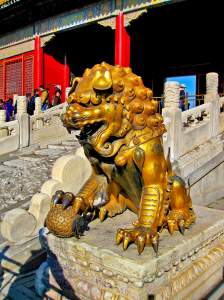Looking for design inspiration? Browse our curated collections!
About this Group
 Any image of a Dragon.
Any image of a Dragon.
A dragon is a mythological representation of a reptile. In antiquity, dragons were mostly envisaged as serpents, but since the Middle Ages, it has become common to depict them with legs, resembling a lizard. Dragons are usually shown in modern times with a body like a huge lizard, or a snake with two pairs of lizard-type legs, and able to emit fire from their mouths. The European dragon has bat-like wings growing from its back. A dragon-like creature with wings but only a single pair of legs is known as a wyvern. A dragon is a legendary creature, typically with serpentine or reptilian traits, that features in the myths of many cultures. There are two distinct cultural traditions of dragons: the European dragon, derived from European folk traditions and ultimately related to Greek and Middle Eastern mythologies, and the Chinese dragon, with counterparts in Japan (namely the Japanese dragon), Korea and other East Asian countries. The two traditions may have evolved separately, but have influenced each other to a certain extent, particularly with the cross-cultural contact of recent centuries. The English word 'dragon' derives from Greek (drakon), 'dragon, serpent of huge size, water-snake'.The word dragon entered the English language in the early 13th century from Old French dragon, which in turn comes from Latin draconem (nominative draco) meaning 'huge serpent, dragon,' from the Greek word, drakon (genitive drakontos) 'serpent, giant seafish'. The Greek and Latin term referred to any great serpent, not necessarily mythological, and this usage was also current in English up to the 18th century. In East Asia, the concept of dragon appears largely in a form of a Long, a beneficent dragon-like creature from Chinese folklore. Another dragon-like creature is a Naga, which is prevalent in some Southeast Asian countries with more direct influence from Vedic religion.A dragon is a mythological representation of a reptile. In antiquity, dragons were mostly envisaged as serpents, but since the Middle Ages, it has become common to depict them with legs, resembling a lizard. Dragons are usually shown in modern times with a body like a huge lizard, or a snake with two pairs of lizard-type legs, and able to emit fire from their mouths. The European dragon has bat-like wings growing from its back. A dragon-like creature with wings but only a single pair of legs is known as a wyvern. Dragons and dragon motifs are featured in many works of modern literature, particularly within the fantasy genre. Prominent works depicting dragons include J.R.R. Tolkien's Silmarillion and The Hobbit, J. K. Rowling's Harry Potter novels, Anne McCaffrey's Dragonriders of Pern, George R. R. Martin's series A Song of Ice and Fire, and Christopher Paolini's tetralogy Inheritance Cycle.The popular role playing game system Dungeons & Dragons (D&D) makes heavy use of dragons, and has served as inspiration for many other games' dragons. Though dragons usually serve as adversaries, they can be either good or evil, with their alignment being determined by their species. For example, a red dragon is evil and breathes fire. Dragons are often held to have major spiritual significance in various religions and cultures around the world. In many Asian cultures dragons were, and in some cultures still are, revered as representative of the primal forces of nature, religion and the universe. They are associated with wisdom—often said to be wiser than humans—and longevity. They are commonly said to possess some form of magic or other supernatural power, and are often associated with wells, rain, and rivers. In some cultures, they are also said to be capable of human speech. In some traditions dragons are said to have taught humans to talk. Narratives about dragons often involve them being killed by a hero. This topos can be traced to the Chaoskampf of the mythology of the Ancient Near East (e.g. Hadad vs. Yam, Marduk vs. Tiamat, Teshub vs. Illuyanka, etc.; the Biblical Leviathan presumably reflects a corresponding opponent of an early version of Yahweh). The motif is continued in Greek Apollo, and the early Christian narratives about Archangel Michael and Saint George. The slaying of Vrtra by Indra in the Rigveda also belongs in this category. The theme survives into medieval legend and folklore, with dragon slayers such as Beowulf, Sigurd, Tristan, Margaret the Virgin, Heinrich von Winkelried, Dobrynya Nikitich, Skuba Dratewka/Krakus. In Biblical myth, the archetype is alluded to in the descendants of Adam crushing the head of the Serpent, and in Christian mythology, this was interpreted as corresponding to Christ as the 'New Adam' crushing the Devil. European dragons exist in folklore and mythology among the overlapping cultures of Europe. Dragons are generally depicted as living in rivers or having an underground lair or cave. They are commonly described as having hard or armoured hide, and are rarely described as flying, despite often being depicted with wings. The blood of a slain dragon is depicted as either beneficent or as poisonous in medieval legend and literary fiction. In German legend, dragon blood has the power to render invincible skin or armor bathed in it, as is the case with Siegfried's skin or Ortnit's armor. In the Slavic myth, the Earth refuses it as it is so vile that Mother Earth wishes not to have it within her womb, and it remains above ground for all eternity. The blood of the dragon in Beowulf has acidic qualities, allowing it to seep through iron. Heinrich von Winkelried dies after the blood of the dragon slain by him accidentally drips on him.
Please Wait...